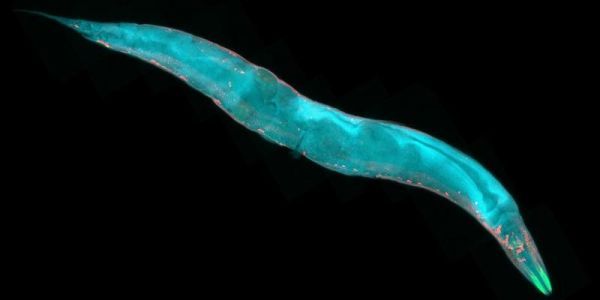Taste cells can control a whole animal’s foraging

Neuroscientists have developed a computer model to explain how a nematode worm searches for food, revealing that single brain cells can both sense the environment and control foraging strategy.
The study, involving a team of scientists from Leeds and the Erasmus University Medical Centre in Rotterdam, involved the microscopic nematode species Caenorhabditis elegans.
In a paper published today in the journal Communications Biology, the researchers show that sensory cells in this animal are not only picking up signals from the environment, but also processing that information to drive decision-making that dictates the animal’s motion.
Up to now, scientists had generally believed information from sensory cells was sent to other circuits in the animal’s brain for decision making and to control behaviour.
Professor Netta Cohen, Computational Neuroscientist in the School of Computing at Leeds and co-lead author in the paper, said: “Our findings are startling – we found simple mechanisms by which salt tasting cells drive a rather sophisticated strategy to forage for food.”
Our findings are startling – we found simple mechanisms by which salt tasting cells drive a rather sophisticated strategy to forage for food.
Foraging pattern
The species C. elegans feeds off bacteria in patches of rotting vegetation in soils. These patches of food are likely to vary in size and be some distance apart, with the result that worm colonies undergo a “boom or bust” existence. For an individual animal, successfully foraging for food is a matter of life or death.
To increase its chances of survival, the worm has evolved a foraging strategy where it will randomly criss-cross an area in search of food: if it finds no food, the animal will move away in search of other areas with possible food.
The researchers performed experiments and developed a model which explains how the worm’s taste sensors process information from the environment to direct its foraging.
They believe the worm uses its taste of salt in the soil as “navigation beacons”, moving into salt patches and then, if food is not found, away from them.
Sensory cells attracted to salt
The nervous system of C. elegans contains 302 cells, including two taste cells that are stimulated by the presence of salt. These two sensory cells respond differently: one is stimulated by increasing salt levels, the other by decreasing salt levels.
The starting point for this study was the discovery by researchers led by Dr Gert Jansen in Rotterdam that, when one of these cells is active, the other is “asleep”.
Professor Cohen said: “When a nematode first senses a salty environment, the sensory cell that is sensitive to increasing salt concentrations is stimulated and provides all the information the animal needs to steer into the salt patch.”
But if the animal does not locate food after a few minutes, the sensory cell becomes de-sensitised. Meanwhile the other taste cell, stimulated by decreasing salt levels, becomes active, inducing sharp turns that help keep the animal on the salt. The result is that the animal preferentially explores larger patches of salt.
Both the sensory cells work to keep the worm foraging on a salt patch. But what happens if it fails to find food? Dr Gert Jansen and his group discovered that two additional sensory cells are recruited to the salt sensing circuit when animals are exposed to salt.
It was initially thought that these additional sensory cells alerted the worm to dangers in the environment, allowing it to abruptly change direction and get out of harm’s way. But the study has revealed that these harm-avoidance cells also toggle on and off as part of its navigation strategy, allowing it to sharply change direction to avoid the salt, thus extending its foraging range.
Over time, all the sensors continue to cycle between their on and off states, in this way controlling a rich and dynamic foraging strategy.
Professor Cohen said: “We think this is a mechanism built into these sensory cells. Not only is it remarkably effective, but surprisingly, because it all takes place inside the sensors, it is very easy to implement with the basic toolkit that nearly all brain cells have at their disposal.
“While C. elegans may use salt cues to forage for food, we suspect similar mechanisms may be used by other animals to selectively attend to other cues or features of the environment.”
Further information
The paper, “Plasticity in gustatory and nociceptive neurons controls decision making in C. elegans salt navigation”, can be downloaded from Communications Biology.
The study was funded by the Engineering and Physical Sciences Research Council and the Center for Biomedical Genetics, the Royal Netherlands Academy of Sciences.
Earlier this year, Professor Cohen’s team at the University of Leeds revealed in a paper published in the journal Nature, that they had mapped the physical organisation of the brain of C. elegans.
Top image credit Adobe Stock
For more information, please contact David Lewis in the media office at the University of Leeds via d.lewis@leeds.ac.uk




